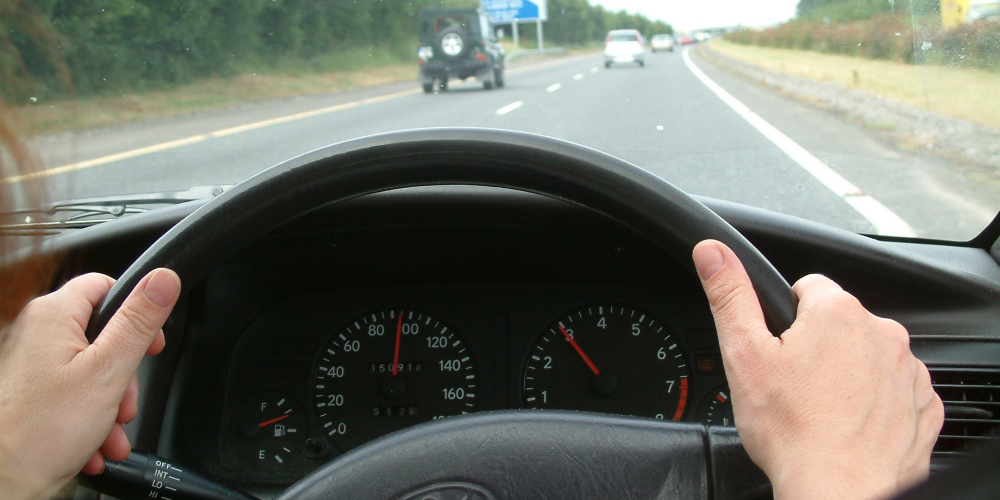
Perhaps we are stating the obvious when we say that steering is an essential skill that you need to master early in your course!
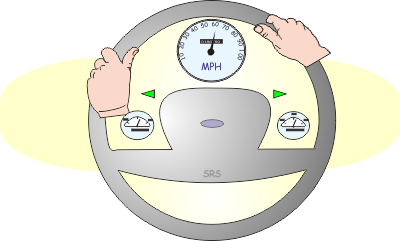 There's lots of discussion about the 'right' and 'wrong' way to steer, instructors sometimes have different ideas - but this need not be confusing as long as you remember this simple fact:
There's lots of discussion about the 'right' and 'wrong' way to steer, instructors sometimes have different ideas - but this need not be confusing as long as you remember this simple fact:
If the car is consistently going where you want it to go, when you want it to go there, your steering is OK, regardless of your steering method.
If you do an internet search for steering, you will find many different methods. The reason for this is that there are lots of experts! They are all correct, and at the same time, they are all wrong!
Different steering styles can suit different driving situations – and drivers.
Ultimately you will develop your own natural steering style, this might be the same as the experts or your friends and family, or it might be different. The examiner will only be interested in your steering method during your driving test if you are not steering accurately and safely.
One rule that everyone accepts is that, as a general rule, you should keep both hands on the steering wheel for as much time as possible - also that a good hand position when driving straight ahead is around the 'ten-to-two' or 'quarter-to-three' position.
Keeping your hands in the 'ten-to-two' position because:
it gives good straight-line control
it helps to ensure that you can quickly turn left or right in an emergency
having your hands in this position is also handy for the 'stalk controls' (indicators, lights, wipers, cruise control' etc.)
IMPORTANT: Most of the information in this lesson is about observation - getting this wrong can add months on to the time it takes to learn, costing £100's extra for driving lessons.
By following the information in this lesson, you will learn to steer well, and you will not have any steering worries during the test.
The examiner wants to see smooth, safe, accurate steering and will not be concerned about your steering method as long as you remain in complete control.
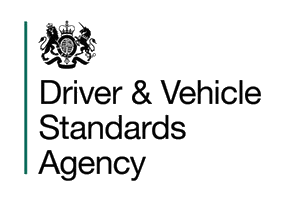
Throughout the drive, the examiner will consider:
The accuracy of your steering
How smoothly you steer
Problems marked by the examiner include
Erratic steering
Overshooting the correct turning point when turning right or left
Taking both hands off the steering wheel
Hitting the kerb
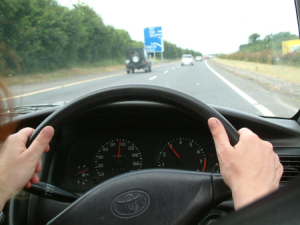
For effective and accurate steering, your eyes need to send the appropriate information to your brain so that it can send the proper commands to your arms and hands. With this in mind it's essential to wear your glasses or contact lenses if you need them for driving.
It's illegal to drive without glasses/contacts if you need them to pass your test or if your eyesight drops below the standard required for the driving test.
Your brain is a bit like a computer - there's an old computer programming saying: 'garbage in, garbage out', which means if you input the wrong information, the computer will simply produce a load of rubbish.
When it comes to steering, your brain is the same as a computer. It can only process the information it receives from your eyes, so you have to ensure that your eyes are pointing in the right direction and gathering the appropriate information. Wearing your glasses/contacts will be of little use if you don't use your eyes properly.
With the above information in mind, the first rule for steering is:
Aim at what you want to hit!
Now ... Your first response to the statement 'aim at what you want to hit' might be "I don't want to hit anything!"
But ... You will be drawn towards whatever you look at...
You will probably hit parked cars and other obstacles if you look at them! (Or if you are lucky, have a near miss.) By the same token, if you 'aim' at the clear spaces ahead, that's where the car will go.
Sometimes if a new driver becomes 'fixated' on an object, it becomes impossible for them to steer away (ask any driving instructor).
Almost all steering problems are related to observation.
Because things are happening when you are driving (and the scene can change quickly), you need to keep your eyes moving; this is similar to watching a film from the front row of a widescreen cinema. You won't get the big picture if you don't move your eyes.
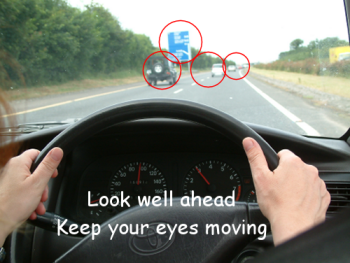 By looking well ahead and keeping your eyes moving, you will gather as much information as possible about the traffic scene and the spaces you intend to drive into.
By looking well ahead and keeping your eyes moving, you will gather as much information as possible about the traffic scene and the spaces you intend to drive into.
By keeping your eyes moving and looking well ahead for steering, you will better judge narrow gaps.
It's much easier to judge a gap or traffic situation from well back, where you can see the full extent of the situation, rather than from close up, where you can only see part of the picture.
When steering through narrow gaps, for example, between parked cars, keep looking well ahead and aim for the clear space, and you will always be on the correct course without having to focus on the obstructions.
Looking well ahead is like throwing a dart or shooting an arrow from a bow. You take aim from a distance, but the arrow follows the correct course (as long as you are a good shot!)
As a pedestrian, you will look about five metres ahead; this is fine when walking at two or three miles per hour. However, you are going much faster than this when driving a car. You will need to look much further ahead at 30 mph (walking speed x15). A minimum of about 60 metres is a good starting point.
So far we have covered three main rules for steering:
Aim at what you want to hit! (The space)
Keep your eyes moving
Look well ahead
In the rest of this lesson, you will learn how to make these 'rules' work for you.
One of the main rules for steering is 'keep your eyes moving' - in other words, scan the road ahead (and behind). By doing this, you will not only help you to spot problems early, but it will also help with your road position.
Remember the 'safety line' covered in the moving off and stopping section? Scanning the road will help you follow a safety line at all times.
The diagram gives you an idea of where experienced drivers look and what they look for - each area is explained below.

(Shaded in pink) This is the immediate area around the car and is especially important near schools, playgrounds, pedestrian crossings, junctions, parked vehicles, etc.
Many new drivers pay too much attention to this area. If you place too much of your attention here, everything will seem to happen very fast, and you will spend a lot of time avoiding things and having near misses - because you will see things too late.
Usually, when checking this area, it will be as a result of some other information you have already gathered from looking further ahead. You might be checking children you spotted playing on the path; you might have slowed down to look into the hidden area behind a parked vehicle or a blind junction.
Apart from specific checks, your peripheral vision will continually monitor this near distance. Peripheral vision, sometimes known as indirect vision, is the area outside of your direct focus; it's 'programmed' to detect movement.
(Shaded in blue) This is where you take action to deal with hazards that you have already seen. If you are unsure how a situation might develop when there is a hazard in this area, you must slow down.
(Shaded in green) When you see things this far ahead, you are starting to decide what to do - developing your driving plan.
You need to allow for the actions of other drivers, especially those who are driving too fast or who don't seem to be paying attention to the road; consider your plan to deal with others, and estimate a safe speed.
(Shaded in yellow) Look for brake lights, bends, junctions, etc., you can also spot road signs early to give advance warning of potential problems. Although the signs might be too far away to see clearly you will be able to see the shapes of the signs, this in itself can be useful for planning your drive.
Look for brake lights, bends, junctions, etc.; you can also spot road signs that will give you an early warning of potential problems. Although the signs might be too far away to see clearly, you will be able to see the shape of the signs; this in itself can be useful for planning your drive.
(Shaded in purple) You need to keep an eye on what is happening behind you because the information about any following vehicles is essential when making decisions about how to deal with situations ahead.
When steering the car, you are simply negotiating a giant obstacle course. You need to look well ahead for the gaps between the obstacles to get through safely!
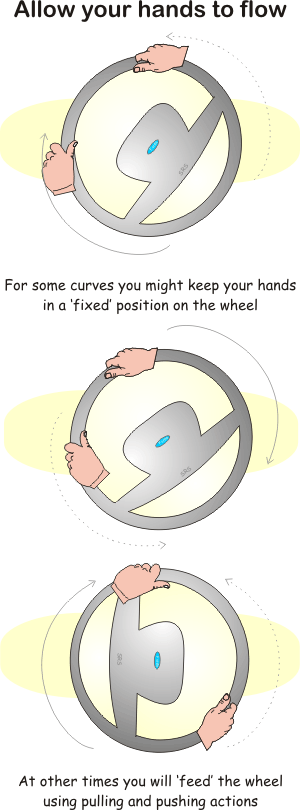
At the beginning of this lesson, we mentioned that there are many 'experts' who will tell you that there is only one way to steer - but then the world is full of experts...
They might know something about steering, but what do they know about you?
Steering is the one thing that we do all the time when driving - it is essential that you find a method that feels natural and comfortable for you.
We won't tell you how to steer, but we will give you some ideas about what is and isn't practical.
For many years the 'pull-push' steering method was generally accepted as the best way to maintain steering control. But the problem with this method is that many people find it unnatural and confusing to learn - as a result, they stop doing it as soon as they pass the driving test.
The pull-push method was developed many years ago when cars were difficult to steer - steering needed quite an effort in those days and pulling the wheel down was essential to get the leverage needed to turn the wheel, especially at low speeds.
Modern vehicles have 'power-assisted steering', and though I wouldn't recommend it, they are so easy to steer that you could probably steer most cars with one finger.
The pull-push method is reasonably straightforward. You pull with one hand while the other slides down the wheel. Then you push with the other hand while the first hand slides up the wheel. The strict method dictates that your hands should not go beyond the top (12 o'clock) or bottom (6 o'clock) of the wheel.
Most, if not all, steering will involve pulling and pushing the wheel, but not in the rigid method defined by the pull-push method - having said that, if it's comfortable and natural for you, use it.
The pull-push method is not a driving-test requirement.
The fixed arm method is mainly suited to open road driving. This is a method used by performance drivers, for example, police drivers, when driving at high speed. This technique is not generally recommended for inexperienced drivers simply because you need a good 'feel' and sense of judgment about exactly how much steering is required in any given situation - this only comes with lots of experience and practise.
The method works with the driver keeping their hands at a fixed position - usually a 3 o'clock and 9 o'clock position and then turning the wheel to the left or right without changing the hand position on the wheel. This method can't be used for turning corners, for example, at junctions.
Natural steering is whatever works best for you.
When developing your steering style, concentrate on your observation and allow your hands and arms to look after themselves.
For most people, natural steering is a mixture of pulling and pushing and the fixed hand approach.
It's worth 'playing in the park' to get a feel for steering - find an empty car park or patch of waste ground and drive slowly around in circles, figures of eight and zig-zags. After a while, you will find that you can 'aim' the car accurately.
Remember that the emphasis should be on what you are doing with your eyes, not your hands; concentrate on where you want the car to go. When zig-zagging around a car park, this might sometimes mean looking back over your shoulder as you steer the car around.
 One hand
One hand
Some people steer with one hand either because they are lazy or think it looks cool.
Using one hand, you will have very little control if
the car hits a pothole
if a child runs out into the road
if a tyre bursts
Or in any other emergency.
One handed steering gives even less control when your arm is resting on the window ledge or centre armrest.
The only exceptions to the one-hand rule are as follows.
When learning (with an instructor):
One-handed steering helps some people get used to the 'feel' of the steering; this can help them keep control when changing gear or operating other controls.
To help people who grip the wheel too tightly. However, the aim of the exercise is not to learn how to steer with one hand; it's simply to gain more of a 'feel' for the steering.
When reversing:
Using one hand on the top of the wheel can make steering easier while turning in the seat to look backwards.
No hands!
Some drivers think that rolling a cigarette, texting or whatever else while steering with their knees is a great skill. The potential consequences of this kind of attitude include severe injury and death. When drivers steer using their knees, they are distracted - not only is this illegal, it's madness.
To steer safely, you need your hands on the wheel and your eyes on the road.
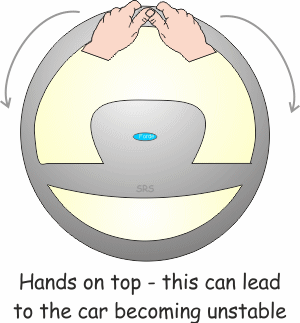
Hands on top
Sometimes you will see drivers with both hands together on the top of the wheel. To steer, they 'rock' the wheel from side to side.
This steering method is dangerous in many situations, especially when travelling at speed; the car can easily become unbalanced leading to a total loss of control.
Spinners
Generally speaking, it's not a good idea to allow the steering wheel to spin back to the straight-ahead position on its own after turning. Although modern steering design causes the wheel to self-centre, it doesn't allow for uneven road surfaces, potholes, and other problems. There is the possibility that the wheel will spin too far before you regain full control. If you allow the wheel to 'self-centre', ensure that it does so under your control by 'damping' the spin as the wheel turns.
Some 'emergency handling' experts suggest that it is best to let go of the wheel in a high-speed emergency skid and allow the car to self-correct; however, there are a couple of things to consider here. Firstly it's much easier to avoid emergencies in the first place. Second, if you want to try this, get some high-performance driver training after a few years of experience behind the wheel.
Under arm spin
It's not a good idea to put your hands inside the steering wheel rim when pulling it around.
Some people do this when turning. They put their hand inside the wheel and grip the top of the wheel with their palm facing their face, presumably for more leverage - but with modern cars, you don't need leverage; power-assisted steering makes the wheel turn effortlessly.
Steering this way, you can 'run out of wheel' mid-turn as you fumble to move your arm out of the way of the steering wheel spokes.
The two videos below are of differently abled people - commonly described as disabled.
I've used the term 'differently abled' here, not out of political correctness, but because it accurately describes their skills. They demonstrate that it's possible to steer safely without the old pull-push method. Indeed without any arms at all.
Steering style is personal - the best steering method is that which is natural to an individual.
In the first video, Tisha introduces her car and shows how she drives with no arms. In the second video Bartek Ostalowski, a Polish racing driver, shows just how much car control is possible with no arms!
Show these videos to anyone who tells you that you have to pull and push in the strict, old-fashioned way, and it doesn't suit you!
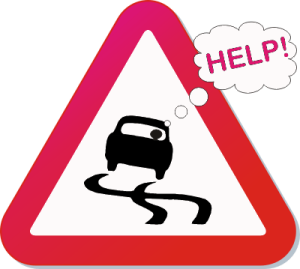
As mentioned earlier, virtually all steering problems stem from observation - garbage in, garbage out; most of the issues below fit this category.
Some new drivers have a habit of shuffling the wheel - only moving the hands a few centimetres rather than taking large sweeps when turning the steering wheel.
Shuffling becomes a significant problem during manoeuvres that need a lot of steering input, resulting in under-steer. In other words, it won't turn enough, and you will run out of space.
Resting your arms on the window ledge or holding the wheel in unorthodox positions will eventually cause problems.
Stick with the 'ten-to-two'/'quarter-to-three' steering position as taught by your instructor; this will keep your body balanced in the seat and give the best control.
Looking at the left-hand kerb or edge of the road instead of well ahead will cause the car to drift to the left. The opposite happens if you look at the centre line.
Remember to look well ahead and aim for what you want to hit - that is, aim to hit the empty spaces.
If you concentrate on any single thing for too long, you will drift towards it.
Looking for too long at any fixed point will cause problems; if something on the road needs particular attention, keep flicking your eyes away and then back again, as explained earlier with the visual scanning diagram.
There is a related mirror use problem. You risk drifting off course if you ‘stare’ in the mirrors for too long; several glances are better than a ‘long look’.
In context - fixing your eyes for just one second will often be far too long.
Turning right is an example of where looking well ahead is essential - in this case, looking well into the side road.
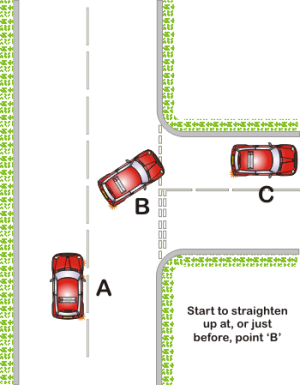
Many new drivers have problems steering when turning right into side roads and out of very tight side roads or parking spaces; they are looking in the wrong place!
The 'natural' tendency is to look at the end of the bonnet or directly in front of the car when doing a right turn, but you should be looking through your driver's door window.
The driver starts to steer at point 'A' on our diagram. Their observation should be through the driver's door window, towards point 'C'.
At point 'B', the driver's head will be moving back to the front as the view of point 'C' moves from the driver's door window to the windscreen. Your hands follow your eyes as your head starts to turn back while still looking at point 'C'.
The wheel should turn (gently) to straighten up the car as the driver's head moves back towards the front of the vehicle. Although the car is still positioned at an angle across the road at point 'B', the front wheels are pointing towards point 'C'.
Drivers who do not 'aim at what they want to hit' (by looking towards point 'C') will usually straighten up late and need to rush the steering, turning the wheel faster than is necessary.
 Steering Quiz ...
Steering Quiz ... Click here to complete the quiz for this lesson
(The page will open in a new window/tab)
You will find references for the answers in this lesson.
You can check your answers as you go along, or complete the full quiz before checking.
Leaving the check to the end is a good way to test yourself.
When you check or review your answers you will get a brief explanation of the answer.
Good Luck!